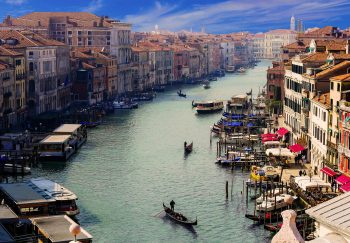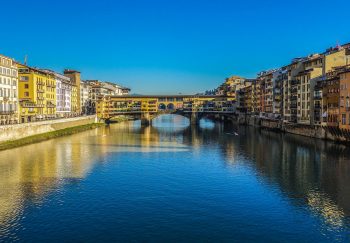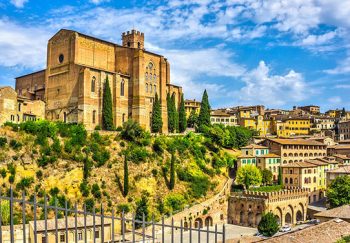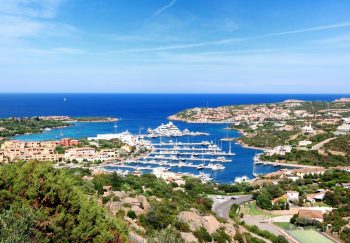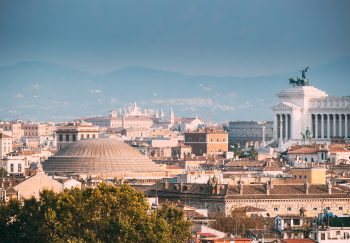St. Peter’s Basilica is a magnificent church. It’s easy to forget that Rome boasts over 900 churches. We understand that you may just want to visit St. Peter’s. However, if you are looking for more information about the area, there is plenty of beauty and religious significance waiting for you. This is a list of the top churches in Rome that we recommend for pilgrimages to Rome, or simply if you love beautiful architecture and art.
The Basilica di Santa Maria Maggiore
St. Mary Major is the largest church in Rome dedicated exclusively to the Virgin Mary. Mary Major is the most prominent of the city’s churches. Every inch of this church is filled with artifacts and art. Although the church’s beautiful facade from 18th century appears Baroque, it is actually one of Rome’s oldest churches, having been built around 440.
The church’s long history is best illustrated by the 5th-century mosaics above the main altar and the nave walls. These mosaics depict 36 scenes from God’s Old Testament. Santa Maria Maggiore is a great example of an Early Christian basilica in Rome, as it has not been rebuilt or remodelled like Rome’s other major basilicas. It’s a popular church that anyone visiting Rome from all over the world considers.
The external façade of the apse on the north-west of the church on Piazza dell’Esquilino
Every August 5, thousands of white flowers fall from the ceiling at the Basilica’s Miracle of the Snows celebration. This event celebrates the legend of a magical summer snowfall.
More Information:
The Basilica is open every day from 7:00 am to 6:45 pm. The museum is free and open daily between 9:30 a.m. and 6:30 p.m.
Piazza Santa Maria Maggiore, Rome, Latium, 00185, tel. 06-69886802
San Lorenzo Fuori le Mura
This isn’t a church that you would consider one of the Rome churches. The St. Lawrence Outside of the Walls Basilica was built by Constantine, outside of Rome, over the tomb of St. Lawrence. He was a martyr and one of the first Roman deacons. It is a shrine to St. Stephen, St. Justin and St. Lawrence today. The church was built in the 6th century. It still contains Byzantine mosaics dating back to that time, which depict Christ and the saints. The exterior is decorated with frescoes from the 13th century. Next to the tomb of St. Lawrence, the “stone of St. Lawrence” is a marble slab with a large stain that marks the spot where the saint’s body was placed after his execution. Since its construction, the Basilica has been funded almost by every Pope. This transformed the small shrine into one the most important religious complexes outside of Rome’s walls. It is still a place of worship and a site of pilgrimage to Rome.
Inside the cloister
More Information:
Piazzale Del Verano, 3 Quartiere San Lorenzo, 00185, tel. 06 44 66 184
San Giovanni in Laterano
St. John Lateran, not St. Peter’s!) It is also the seat of the Bishop of Rome, a.k.a. The Pope. The cathedral is one of four basilicas in Rome. It was built in 4th century AD. It is believed to have been the first Catholic church in Rome. The original church has been destroyed by fires, vandals, and earthquakes. The church now has a Baroque style, with restorations from 16th and 17th centuries.
Although the exterior isn’t spectacular, the interior more than compensates. Nearly every inch of this ornate Roman church is decorated with frescoes, columns and mosaics as well as sculptures. Roman pilgrims must see the column fresco by Giotto and the altar’s rich 1367 Gothic Tabernacle, which holds what the faithful believe to be the heads of the Sts. Peter and Paul, as well as the Baptistery constructed by Emperor Constantine (AD 315). It is one of the most important Roman pilgrimage churches and one of the oldest Christian structures that survives.
The oldest public church in the city of Rome and the oldest basilica of the Western world.
More Information:
The church is open every day from 7 a.m. until 6:30 p.m. The Baptistery is open daily between 7:30 a.m. to 12:30 p.m., and 4 – 6:30 p.m.
Piazza di Porta San Giovanni, Rome, Latium, 00185, tel. 06-69886433
Santa Maria in Trastevere
Santa Maria in Trastevere is a must-see on any list of stunning churches. It is a church that was built in Rome around 350 AD. However, it is also one the most beautiful. This church, built in 4th century AD, was probably the first to hold Mass openly in Rome. It is also believed to be the first church to dedicate itself to the Virgin Mary. It was rebuilt in 12th century by Pope Innocent II, a Trastevere native. Today, it has impressive mosaics from both the 12th and the 13th centuries. The nave is accessed by 22 large columns that lead to two rows. Most of these were taken from Roman baths or temples and repurposed. The altar is covered with gilded mosaics. Domenichino’s 1617 gilded ceiling is worth a look. If mosaics are your passion, check out our list of the best Byzantine Mosaics in Italy.
Behind the altar, Basilica of Santa Maria
More Information:
The church is open every day from 7:30 a.m. to 9 p.m.
Piazza Santa Maria in Trastevere, Rome, Latium, 00153, tel. 06-5814802
Santa Maria Sopra Minerva
Santa Maria Sopra Minerva got its name because it was built on the site of an ancient temple dedicated to Minerva, the goddess of wisdom. According to the website of the Basilica, the Basilica actually sits over three ancient Roman temples. One for Minerva, the Egyptian goddess Isis, and one for Serapis the Greco-Egyptian God.
Santa Maria Sopra Minerva, the first and most important Gothic church in Rome, is Santa Maria Sopra Minerva.
It’s not the location that makes it one the most popular churches in Rome for pilgrims. It’s the architecture. It was built by the Dominicans in 13th century. It is one of Rome’s few Gothic (as against Baroque-styled) churches and one of the most striking Gothic churches in Italy. You can enjoy the most beautiful vaulted ceilings, or for only 1 euro, light the Cappella Cartafa where Filippino Lippi’s frescoes can be found amongst other 15th-century frescoes. A sculpture by Michelangelo is also on display, as well as the tomb of St. Catherine de Siena (Italy’s principal patron saint).
More Information:
Weekdays, 6:45 a.m. to 7 p.m. Sat. 6:45 a.m. – 12:30 p.m. Sun. 3:30 p.m. – 7 p.m. 8 a.m. to 12:30 p.m., and 3:30-7:00 p.m. to 7 p.m.
Piazza della Minerva, Rome, Latium, 00186, tel. 06-6793926. Click here for more information. www.basilicaminerva.it
Basilica of Santa Maria del Popolo
While tourists to Rome may overlook the small church at the Piazza del Popolo, the interior is a treasure trove of art for those who love it. Seven chapels are located in the church, which include some of the finest examples of Renaissance art, such as Pinturicchio’s, Bernini’s and Caravaggio’s.
The Altar, Basilica of Santa Maria del Popolo
Legend has it that the church was built to dispel the belief that Emperor Nero’s ghost haunted the area in 1099.
More information here:
Mon.-Thurs. 7:15 to 12:20 p.m., and 4-7 p.m. on Fri. and Sat. Sun. 7:30 a.m.-7 p.m. 7:30 a.m. to 1:30 p.m., and 4:30-7:30 pm.
Piazza del Popolo 12, near Porta Pinciana, Rome, Latium, 00186, tel. 06-3610836. For more information, click here.
Basilica of San Clemente
The Colosseum is just a few blocks from St. Clement’s Basilica. It’s named after St. Clement III, Catholicism’s third Pope. The real attraction is archeological. The Basilica of the 12th century is built on top a 4th-century church, which was in turn built on top a 1st-century pagan temple. All three can be viewed today. Its history clearly shows that Rome was built layer by layer. The difference in ground level between today and the 1st Century is almost 60 feet. The church’s top floor has stunning mosaics and frescoes. For example, the 12th-century mosaic depicting Jesus on a cross which transforms into a living tree. Next, visit the mithraeum which is a shrine to the god Mithras. It was built in Persia and Rome in the 2nd, 3rd centuries. The temple was destroyed by Roman christians. It’s today one of the most hidden underground locations in Rome.
You can take a guided walk to discover the amazing crypts or catacombs of Rome.
Mithraeum, the Basilica of San Clemente
Santa Cecilia in Trastevere
St. Cecilia is Trastevere, a 9th-century church built over the 200-AD home of St. Cecilia. Stefano Maderno has created a sculpture of the saint’s corpse that is located below the main altar. This was taken from the 16th century, when she was exhumed. According to legend, her body looked fresher than the day she was buried. The beautiful Roman courtyard and facade conceal the entrance to the church. The interior is decorated with a 9th-century mosaic and a 13th-century fresco called Last Judgement by Pietro Cavallini. This remarkable fresco was a precursor to Giotto. It is only open during limited hours, and there is a small fee for admission. However, it’s well worth the price, especially for those on a Roman pilgrimage.
The Last Judgement by Pietro Cavallini
More Information:
The church is open free of charge from 9:15 to 12:45 p.m., and 4 to 6 pm. The frescoes can be viewed from 10 to 12:45 p.m., and 4 to 6 p.m.
Piazza Santa Cecilia in Trastevere 22, Rome, Latium, 00153, tel. 06-5899289
Basilica di Sant’Agostino
St. Augustine, a Roman Renaissance church, is full of famous artwork. It is one of the most well-known churches among travelers. Caravaggio’s Madonna of the pilgrims is the most famous. It depicts a realistic, kneeling pilgrim with dirty feet. The Madonna stands with her feet exposed in a disrespectful posture. Raphael’s Isaiah is also available. It is believed to have been inspired by Michelangelo’s work in Sistine Chapel. Sansovino’s sculpture St. Anne and Madonna with Child and Jacopo Tatti’s Madonna and Child are also available.
Basilica di Sant’Agostino
More Information:
The Basilica is open every day from 7:30 a.m. to noon and 4 7:30 p.m.
Piazza Sant’Agostino, Rome, Latium, 00186, tel. 06-68801962
The Pantheon
The Pantheon, originally a pagan structure, was converted into a Catholic church early in the 7th century. It is still being used today as a church. On Sundays, you can even attend Mass there! It is also known as the Basilica of St. Mary and the Martyrs. The architecture of this ancient building, which was built in the 14th century, is still impressive today. This major tourist attraction must be on the list because its dome is the largest unreinforced concrete dome anywhere in the world. Continue reading for 6 Surprising facts about the Pantheon at Rome. Or, take our Twilight Tour Through Rome to see the Pantheon from a new perspective.
Pantheon
